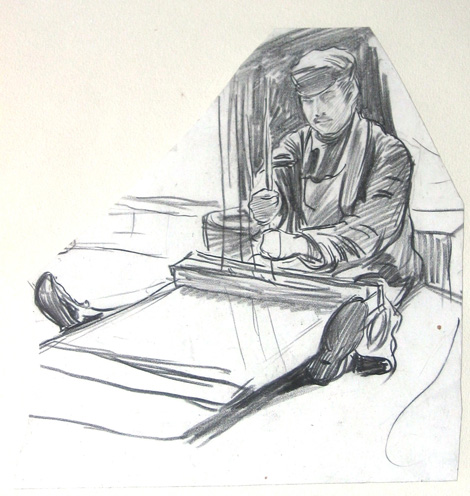The exhibition on the occasion of the 100th anniversary of Hubert Herkomer, which runs at present in the City Museum Landsberg in Germany and which subsequently will be at display in Bushey near London, should actually be shown at the Van Gogh Museum in Amsterdam, at the Pinakothek in Munich and at the Tate Britain. There is hardly an artist of the challenging Imperial Age who would be more worthy of a rediscovery at such exposed locations than this universal artist, who was born in 1849 in the Bavarian village Waal. Herkomer, who was predominantly active in England, began his career in 1870 as an illustrator for the London weekly The Graphic. Together with his colleague, Luke Fildes, he founded a very influential School of social realism.

Hubert Herkomer, On Strike, 1891 (Royal Academy of Arts, London)

Theo Matejko, Fathers out of work, Berlin 1932 (MePri-Coll.) – Matejko´s illustration had apparently been influenced by Herkomers popular painting “On Strike”
His powerful graphic style had a formative influence on the art of Vincent van Gogh, who was only a few years younger. In addition to genre depictions Herkomer soon would specialize on portrait painting and became the most successful portraitist of the era along with Franz Lenbach and John Singer Sargent. John Ruskin nominated him in 1885 as his successor to the legendary Slade Professorship of fine art at Oxford. Moreover, he was one of the most inventive experimenters in the field of graphic reproduction. He also appeared as an innovative poster designer, as a musical composer, a sculptor, a writer of plays, photographer, actor, as well as a film- and and automobile pioneer. Despite of all his versatility he managed to create a number of works that even nowadays haven´t lost much of their suggestive power and topicality. These include paintings like Pressing to the West (1884), Hard Times (1885) and On Strike (1891).

Hubert Herkomer, Hard Times, 1885 (Manchester City Art Galleries)

Hubert Herkomer, Study for “Hard Times”, ca. 1884 (Source: Ludwig Pietsch, Herkomer, Bielefeld 1901)
One can only wonder why Herkomer, who belonged to the most successful Victorian artists of the era, and who was highly estimated in North America and in Germany, fell so deeply in oblivion, whereas nowadays even the most stale Historicism is honored by museal exhibitions and Salon painters of the second and third grade are dragged into the spotlight. One glimpse at the artist’s name and the date of his death should actually be enough to unravel this mystery. The name Herkomer implies a telling reference to the German-born migrant background. He accordingly used his name as a label for his long-standing cultural intermediary activities, which became manifest in different modes of bajuvarian folklore. In the course of rising nationalism at the end of the 19th century, these intermediary activities increasingly led him to fatality. With the entry in the First World War Great Britain wanted to get rid of the memory of this prominent Herald of German culture as soon as possible. 1914, therefore, was a good date for him to finally say goodbye. His private Bayreuth Lululaund, which he had erected in Bushey near London, was destroyed during the Second World War by the British side, probably for xenophobic reasons. But also in Germany, where the artist sought to settle down towards the end of his life, Herkomer remained an outsider.

Hubert Herkomer, Study for “Blind basket-Makers”, 1871 (MePri-Coll.)

Hubert Herkomer, “Blind basket-Makers”, Illustrated London News, 30.9. 1871 (MePri-Coll.)
Despite the intensive and long- standing endeavours for a reappraisal of Herkomer´s work by the city of Landsberg, which has been considered by Herkomer´s descendants with a large donation from the artistic estate, his multifaceted art in Germany never really has arrived. His work is apparently too diverse and contradictory to find entrance into the Canon. While the museums in the metropolises spin round due to opportunism and substantial lack of imagination, the commitment of the periphery for such neglected artists is even more to appreciate. The art historian Hartfrid Neunzert, who as a former head of the City Museum in Landsberg did pioneering work for the last twenty years in the matter of Herkomer, belongs to these incessant people as well as his successor Sonia Fischer, the new director, who is responsible for the exhibition. Just in time for the anniversary date Hartfrid Neunzert edited and commented a large illustrated folio, which focuses on the painterly work of Herkomer. To get an impression of his graphic art one has to fall back on Lee MacCormick Edwards´ monograph Herkomer. A Victorian artist (Aldershot, 1999). Both aspects of Herkomer´s oeuvre are represented in the exhibition. The graphic work is to be seen in the City Museum whereas the historic town hall shows a small choice of his paintings. (A.R.)
Herkomer Centenary Exhibition, Landsberg City Museum, March 29 to August 31, 2014 / Bushey Museum, June 29 to January 11, 2015

Hubert Herkomer, Schuhplatteln, 1875 (Privatbesitz)

Herkomersaal, Rathaus Landsberg am Lech (Quelle: Herkomer, hrsg.Hartfrid Neunzert, Petersberg 2014, Photo: Stephan Wagner)
